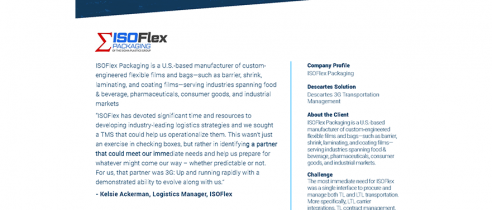The supply chain has been in a state of upheaval since the turn of the decade, impacting not only material availability and shipping reliability, but freight rates as well. In fact, we’ve seen rates fluctuate between some of the biggest extremes in the industry’s history in just the last few years. According to Statista, freight rates dropped to a low of $1,342 per 40-foot container in October 2023, only to nearly triple to $4,200 in May 2024 — some of the highest rates ever on record.
Given how much these costs factor into overall shipping, freight rate negotiation isn’t just a way to save money — it’s critical to overall profitability. Moving forward, you need a negotiation strategy before beginning discussions; your business might depend on it.
The Basics of Freight Rate Negotiation
Freight rate negotiation is a challenging yet essential part of doing business in the transportation and logistics industries, pivotal for any company trying to reduce their shipping costs and enhance profitability. Unlike simple price haggling, freight rate negotiations require a deep understanding of the market, including factors like fuel costs, carrier capacity, seasonal trends, and economic trends that have an impact on pricing.
Successful negotiation strategies involve win-win terms, building solid relationships with carriers rather than just aiming for the lowest possible rates. This approach helps shippers achieve cost-effective, reliable, and flexible shipping arrangements with significant ROI.
6 Freight Rate Negotiation Tips
Freight rate negotiation is much more resource-intensive than just accepting prices posted on a lead board, but effective negotiation strategies can lead to long-term contracts with more favorable terms, volume discounts, and more flexible service agreements. These benefits not only reduce costs but also improve service reliability and efficiency, which further improve your bottom line. Here’s how you can secure the best terms:
1. Prepare, prepare, prepare
Freight rate negotiation should start with developing a thorough understanding of the factors influencing your current rates. Research and document factors that could affect your rates, such as:
- Current market trends, including fuel cost
- Carrier performance metrics, which help gauge their reliability and service quality — impacting future negotiations and whether you continue to use them as vendors at all
- Expected service level requirements, such as special handling needs that may increase costs
- Expected shipping volume and frequency, which may help you secure bulk rates or long-term contracts
2. Understand your freight needs
Look at your historical shipping data to identify the most efficient modes, routes, and delivery times that align with your operational needs. This will allow you to negotiate for more precise services that match your actual demands and avoid unnecessary premiums for services that don’t provide you value.
3. Get quotes from multiple vendors
A common mistake in freight rate negotiations is to settle for quotes from a single vendor. Negotiating with multiple companies ensures that you not only secure the best possible rates but also gain a comprehensive view of the services available. A competitive bidding strategy allows you to find vendors that can serve as valuable backups if issues with your carrier arise in the future.
While exploring different freight carriers, don’t forget to consider small regional and local carriers who can provide more competitive rates in their regions than major carriers operating at the national level. Case in point, the janitorial and sanitary supplier, ursource, reduced shipping costs by $200,000 a year after choosing a regional carrier to augment their national shipping needs.
Multi-modal shipping is another key option to explore for very long distance shipments, allowing you to realize savings from carriers that specialize in air, rail, or sea transport. Utilizing different transportation modes tailored to specific segments of your route or cargo type could both unlock significant savings and speed up delivery if you optimize routes properly.
4. Build long-term relationships
Treat vendors with respect as you negotiate better rates and use the dialogue as a way to better understand their business and needs. This lays the foundation for a fruitful relationship down the line, and could bring your needs into alignment with each other if the industry landscape changes.
5. Compare contract and spot rates
While researching and negotiating with different carriers, don’t just focus on their contract rates — get a comprehensive understanding of their spot rates and the factors that influence them. During negotiations, leveraging the knowledge of when to lock in contract rates for regular shipments or capitalize on lower spot rates due to market fluctuations can maximize cost savings and provide greater flexibility in managing shipping needs.
6. Partner with a freight broker
Working with freight brokers is a compromise between the two extremes of relying solely on posted rates on lead boards and spreading yourself thin negotiating with everyone in the market. Freight brokers have extensive networks and relationships in the industry which they can leverage to secure better terms for themselves and their customers. Though brokers have less wiggle room on the rates they can offer you than individual carriers do, negotiating using the strategies above can lead to additional savings while reducing the number of parties you need to negotiate with.
Save More on Freight Rates With 3G
Successful freight rate negotiation requires managing an incredible amount of information and data points to make the most effective arguments. Transportation software like 3G, a powerful management platform, can both set you up for more successful negotiations as well as reduce your overall need for them.
By providing real-time data analytics, route optimization, and carrier performance metrics, 3G enables shippers to identify the most cost-effective shipping options and streamline operations. This enhanced insight and control leads to direct savings, while the ability to quickly compare rates and services across multiple carriers helps shippers negotiate with greater authority, ensuring they secure the best possible terms. What’s more, 3G can select the best rate for each shipment automatically, significantly reducing the need to negotiate at all.
Want to experience the benefits of 3G yourself? Schedule a demo today.








